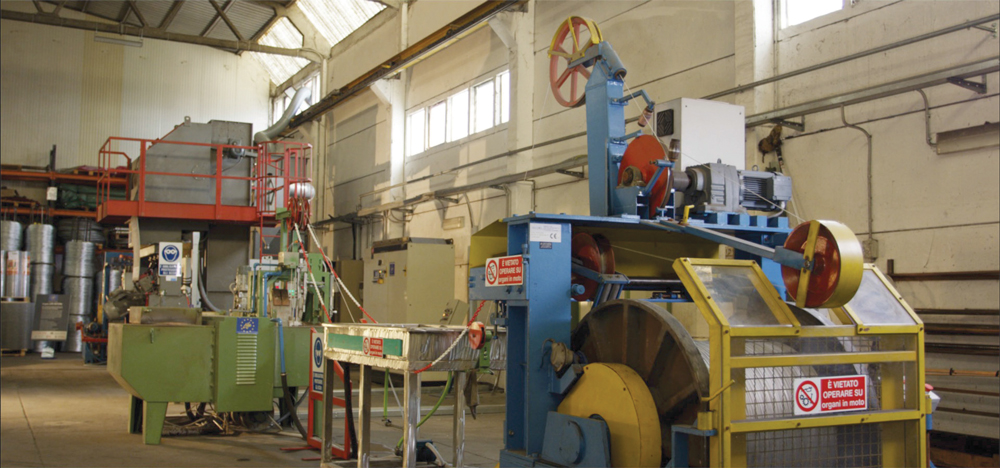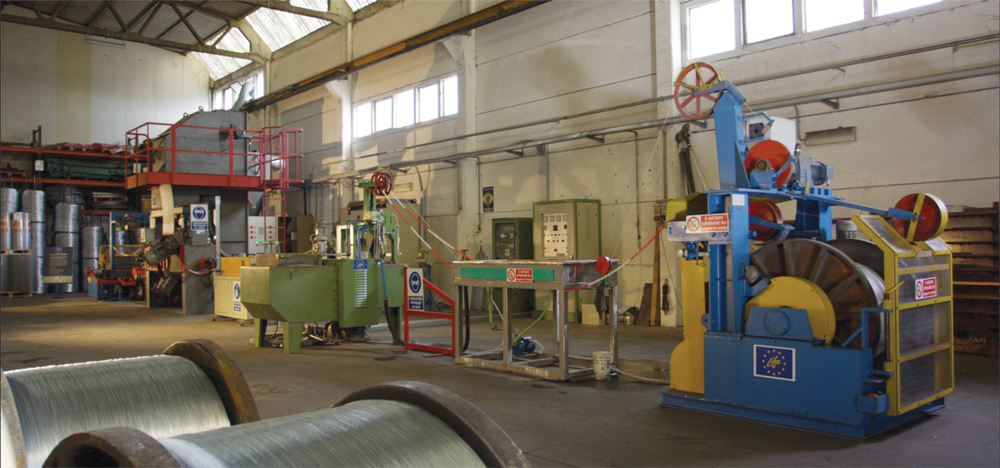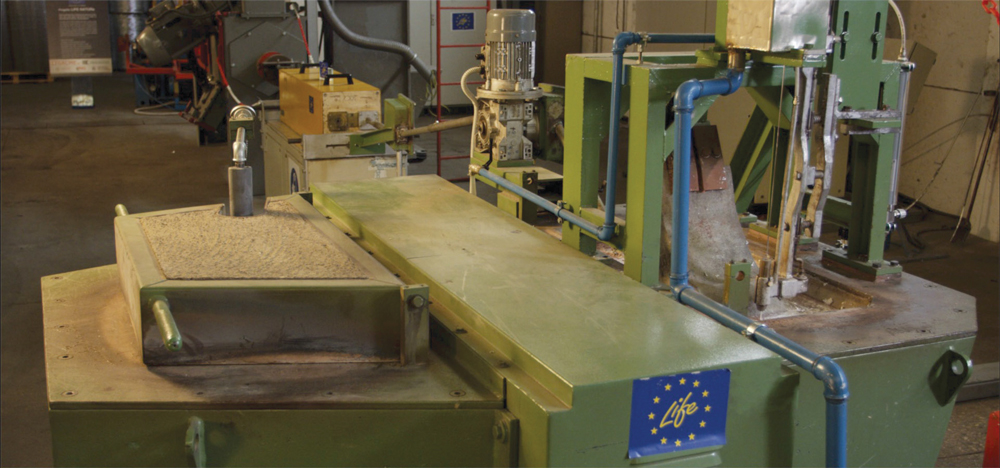The fourth project was started in august 2013 and nearing completion in the Metallurgica Abruzzese’s factories with the collaboration of SACME, University of Modena and Reggio Emilia and University of Marche. Its objective is the reuse and recycling of aluminum and titanium contaminated scraps and chips to obtain the coating of steel wire by an innovative process with low environmental impact. Furthermore, it will be possible to obtain electro-welded meshes with increased performance compared to normal galvanized ones.
An ecosustainable process for wire coating
The ambitious aim of the production process is to obtain both an environmental and a technical/qualitative benefit, being as well the target of a research project supported by the european community. The scope has been reached thanks to a particular process which foresees that the wires are coated with an aluminium alloy, alternative to the traditional hot dip galvanizing process..
Leading companies of the project are the company sacme located in tortoreto and metallurgica abruzzese spa both technologcal partners of the cavatorta group located in parma which is one of the leading european producer of fences and wires for fencing and industry. The gropu is well-known for its engagement in environmental protection thanks to its constant and continuous research and development activities, the group introduced important innovations aiming to reduce the environmental impact of production processes and products.
This article focuses on the environmentally friendly and ecosustainable process of aluminium coating of ferrous materials, in particular on the “new aluminium and titanium use and recycling for the long-term protection of steel”. This project has been developed by the company sacme located in tortoreto, a technological partner company of the cavatorta group which obtained a prestigious award from european commission throughout the admittance to the benefits of the Life+ Program.
The alternative to galvanic or zinc coating
One of the most common and effective methods of wire protection from corrosion is the hot zinc coating. In this process wire should be degreased, pickled, fluxed and pre-heated at 100°c before dipping it in a zinc bath at more than 450°c. It is however known that this system has a strong environmental impact as energy, water and acid consumptions are very high as well as the consumption of resources such as the consupmtion of aprroximate 60 kg of zinc for each ton processed. At the same time we can notice both a production of waste, such as foams, zinc slags, and emissions in the atmosphere such as exhausted fumes from melted zinc baths containing ammonia, hydrochloric acid and powders.
In particular, the aim of the project is the ennobling of waste materials of light alloys, aluminium and titanium, for the sudsequent production of new materials and composite structures having a steel wire core and an external protective coating of light or intermetallic alloy being suitable in case of high corrosive conditions such as a sea environmentor zootechnical applications.
Currently, waste materials of light alloys such as aluminium and titanium are hardly recyclable. For this reason the company aim is to use those alloys in a hot coating process having the scope to coat the steel core with an aluminium or titanium layer thus providing both better mechanical and long lasting properties. The materials obtained with this process can be placed side by side to the traditional galvanized wire being used whenever a higher resistance to corrosion (for example with sea water or ammonia9 is required. The benefits obtained are both of environmental and technical-economical type:
- The use of alloys (aluminium based) coming from a developed recycling market provides consequently a resource saving.
- The energy saving connected to a thermal cycle of coating being more convenient than the traditional galvanizing process having additionally a lower emission of fumes.
- The production of products with longer corrosion resistence mostly in extreme corrosive environments such as sea or in presence of ammonia.
- The competition with the hot dip galvanization in terms of environmental sustainability.
- The use of these new aluminium coated wires also for high temperature applications.
- The massive decrease of costs of about 20% of raw materials, thanks to the use of both light and recycled alloys compared to zinc ingots.
The success of this research is also due to the precious activity of special partners like the engeenering department “enzo ferrari” of the university of modena and reggio emilia , coordinated by prof. Paolo veronesi and roberto giovanardi, and the industrial engeenering department and mathematical sciences of the polytechnic university of marche coordinated by Prof. Mohamad el mehtedi.
About the project
The project was divided essentially in four macro activities : first of all working scrap of light alloys resulting from different processes (turning, milling, drilling, sawing…), it has been recovered and characterized to verify the possibility of hot extrusion, or the necessity of eventual pre heating treatments (emergency plan for chip ti). Additionally, in this phase, the best conditions to obtain a reactive coating on wire using al+ti mixtures have been studied, changing the pressure of granulometry (if necessary) and reaction temperature.
The coatings obtained have been tested to valuate their mechanical properties (microhardness, tensile strength, bending resistence and wearing resistence), composition and morphology (diffraction of x rays, analysis sem, optic metallographic microscopy) and duration (saline fog, potenziometric test). The collection of waste materials and their separation was made in the plants of sacme, whereas characterization and coating were carried out by the labs of modena and reggio emilia university and polytechnic univerity of marche.
In the second phase of the project, aluminium light alloys have been used for the steel wire coating and, in particular two kind of coatings were tested: aluminium based and aluminium-titanium based coatings. To the scope it has been projected a specific extrusor able to operate on temperatures and pressure of the process in order to obtain the above mentioned coatings on steel wire thus keeping its features unchanged.
This equipment allowed to evaluate feasibility and reliability of the proposed project thus enabling to obtain the necessary data for energy evaluation and level of criticality of this process. This phase allowed to set the final version of the plant for continuous and hot alluminium base coating. These activities have been carried out in the plants of “metallurgica abruzzese”, where the new equipment is placed.
In the third phase of the project, the wires pruduced with the above process have been used for the production of new meshes with an improved corrosion resistence in marine environment, in ammonia or high temperatures. Following this both welding and annealing treatments were optimized, and the final product was compared with traditional zinc coated steel wire pruducts. In particular, the accelerated corrosion test in salt fog and potentiometry test have been used to evaluate corrosion resistence of those new products and, therefore, to establish the increase of their life during operation.
Polarization curves allowed to compare bare steel, galvanized steel, aluminium and stainless steel with their pvc coated versions. The last but not the least, heat analysis allowed to study the behaviour of these new meshes at high temperatures, defining the maximum temperature they can stand during the use. These activities has been developed by the polytechnic univerity of marche, with the exception of the welding process performed at metallurgica abruzzese and the main characterization of duration of new meshes executed at modena and reggio emilia university.
The last phase of the project was to use wire coated with the new process in an existing welding line to produce electrowelded meshes. The aim was to define welding parameters in order to obtain a finished product with the same mechanical features of traditional products.
About experimentation
As stated above the first step of experimentation was focused on the selection of production scrap of aluminum and titanium based materials suitable for the project. Thanks to an efficient action of networking, we got in contact with several companies, such as the italian caleffi and others, able to supply both kind of aluminum and titanium based scraps. Those materials have been characterized at the labs of modena and reggio emilia university.
According to this characterization, it has been realized the first prototype of co-extrusor, installed at sacme in june 2016 for the preliminary testing. First tests performed with aluminum shavings gave encouraging results even if not yet optimal : to reach a sufficient adhesion of aluminum, the speed of wire in transit was reduced to such low values to have processing times not applicable on leading scale yet.
Despite the resolution of this problem, successive difficulties, such as problems in the use of titanium shavings due to metal hardness, and difficulties in adhesion of coating, caused the radical reconsideration of wire coating phase anyhow wanting to keep the main objects of the project aat any cost.
We then came to the realization of the next prototype line composed of an electrochemical section for the pretreatment section of steel wire surface (of extremely restrained dimensions); a wire pre-heating section with induction furnace; a wire aluminium coating plant composed of a very little furnace containing a small quanity of molten aluminum. This solution is very versatile, as it is possible to use recycled aluminum even in different format instead of chip: during experimental phase we used also production waste of aluminum bars.
Aluminium ingots of second fusion; a cooling section for aluminium coated wire (in this section the temperature of wire was lowered to allow the subsequent step of titanium powders deposit); finally, a section of coating with titanium powders on aluminium coating taking advantage of material plasticity in conditions of suitable pressure and temperature.
The new wire pre-heating system by means of an induction furnace and aluminium coating presents a set of advantages compared to the coextrusion initially planned:
- The wire in transit undergoes an annealing treatment which improves the mechanical properties (annealing is usually carried out during traditional galvanizing process, in particular, before galvanization);
- The hot laying allows the formation of an intermetallic coating (between the core steel wire and the external aluminium coating) necessary to grant a perfect adhesion of the coating on the wire.
The wire thus obtained and relative electrowelded meshes produced have been characterized in the labs of metallurgica abruzzese, then sent to partners university of modena and reggio emilia and polytechnic univerity of marche.
Conclusions
Tests of potentiodynamic polarization showed that aluminium coated wire, if completely coated without defects, has an higher resistance to corrosion compared to a hot dip galvanized wire.
However, in the first tested samples, the maih problem was the presence of coating dedfects such as local uncovering; corrosion in salt spray test evidencing that those defects are particularly critical as they cause the appearance of red rust in the very early stage. A better control of process parameters and a more efficient pretreatment phase of metallic surface allowed us to obtain wires with a better coating uniformity, free from defects.



